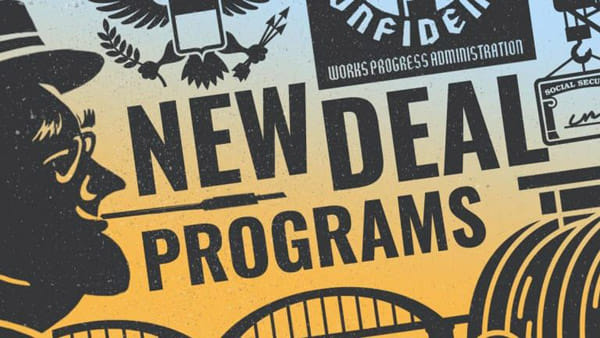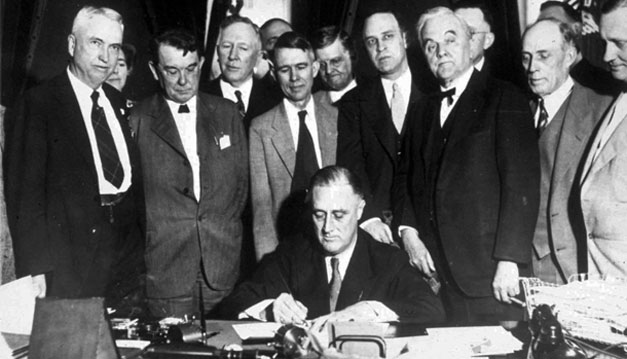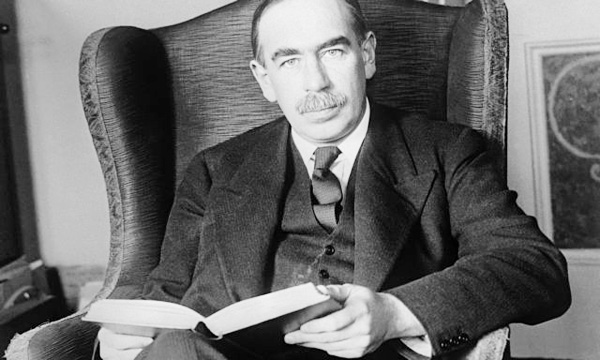Nikos Anastasiadis
This is a second article on the ‘30’s, you can read the firt article here
“So, first of all, let me assert my firm belief that the only thing we have to fear is… fear itself”
Those were the words Franklin Delano Roosevelt used in the opening of his inauguration speech as President of the United States in early March 1933. A few months before he had won the election, as a candidate of the Democratic Party, with 57.5%, against the Republican Herbert Clark Hoover who had been in office until then.

Roosevelt’s election opened a new chapter in the US history, as his policies regarding state intervention in the economy contrasted with the “classical school of economics” as well as with the ideology of the “free market” that had hitherto prevailed worldwide.
The “New Deal”
Roosevelt started his presidency with a dynamic “100 days programme” which incorporated a number of important measures aiming to tackle the crisis. In general, the New Deal was a huge public spending programme, and constituted a turning point in the field of bourgeois economic policies.
Some of the key measures of the New Deal were the following:
- Massive programmes of job creation by direct employment into the public sector, in order to curb unemployment, increase purchasing power and aggregate demand in the economy and tackle the economic crisis. Among other things, Roosevelt established the Federal Emergency Relief Administration (FERA) which created 20 million jobs in the public sector, from 1933 to 1935 (in just 2 years) and the Civilian Conservation Corps (CCC) which created an additional 3 million jobs, again in the public sector, in 8 years. The numbers sound even more impressive if we take into account that the labor force in the US at the time was less than a third of what it is now (approximately 50 million then, approximately 150 million now). These programmes were run on the basis of short-term contracts for the unemployed and the poor. They included programmes to build or maintain public infrastructure, buildings, parks and forests, education schemes, production of basic goods, buying agricultural production which could not be sold and giving it to the poor for free, ect.
- Laws that enforced collective bargaining on the employers, as a way to increase wages in order to prop-up demand. At the time there was an ongoing hard and bloody battle for recognition of trade unions. Roosevelt passed two pieces of legislation (NIRA and NLRA) which promoted collective bargaining for wages and workplace rights. These laws, together with the wave of strikes and struggles after ’34, played their part in the doubling of the trade union density from 13% in 1935 to 29% in ’39. This policy flowed from Roosevelt’s belief that in order to bring back the growth rates in the economy, workers incomes should be raised, even if the capitalists had to pay a price for this. Moreover, in 1935 a law that established a basic social security system was implemented – until then, no such system existed in the US.
- Taxing the rich in order to fund these programmes. The Revenue Act of 1935 (which became known as the “Soak the rich tax”) imposed a taxation of 75% on high incomes (above 500.000 US$ annual). Just to have a sense of proportion, today the highest income bracket in the US is 37%. Harold Ickes, Secretary of the Interior and close collaborator of Roosevelt wrote “the fundamental policy issue today is taxation”. The increases in higher brackets, “taxing surpluses in corporation treasuries, and fear of further increases” had made “a bitter enemy out of practically everyone” among “the very rich” (Federal taxation in America: A short history – W. Elliot Brownlee). Roosevelt’s policies led the top 1% in 1937 to pay more than double the tax they payed in 1932. The results could also be seen in the statistics about inequality between rich and poor, which was at historically low levels during that period.
- Huge investment projects in infrastructure. The most well-known of these projects was the Public Works Administration (PWA) which made contracts with individual constructors and companies to build cities, roads, bridges, airports, dams, schools, hospitals, houses, ect. New York’s Triborough bridge was built at that time, and Hoover Dam was also completed during that period. PWA had a budget of 7 billion dollars, which amounted in 10% of the then US GDP- just for the public works programme.
- A legal framework that put restrictions on the banks. The Glass-Steagall act separated investment banking from retail banks, in order to keep a check on the wild profiteering activities of the “banksters”. This of course didn’t mean that the banks stopped “gambling”. But they were forced to tolerate certain limitations. The bankers achieved to finally repeal this law in 1999, under Clinton’s administration. In a festive atmosphere, Clinton signed the new law that replaced the Glass-Steagall act and stated: “Removal of barriers to competition will enhance the stability of our financial services system”. From the time of that statement it took less than a decade, in the course of which gambling in the stock markets became even more intense, to lead the world economy in the crisis of ’07-’08 …

How come?
Roosevelt’s measures certainly gave some relief to the masses.
It’s only logical that someone asks: “but how”? How can a capitalist government take measures that have a positive effect on the living standards of the workers at the expense of the capitalists’ share in the national income, while challenging the capitalist doctrine of the free market? The answer should be sought in two factors: first, in the depth of the economic crisis in the global economy after the crash of 1929; second, in the fear of the capitalists against the social and political implications of the economic crisis, which could challenge the survival of their system.
Let us let Roosevelt himself speak:
“No one in the United States believes more firmly than I in the system of private business, private property and private profit. … If the Administration had had the slightest inclination to change that system, all that it would have had to do was to fold its hands and wait – let the system continue to default to itself and to the public. Instead … we acted quickly and drastically to save it. It was because of our belief in private enterprise that we acted quickly and drastically to save it”
(The contradictory imperatives of New Deal banking reforms – Ellen D. Russell).
It’s evident therefore that Roosevelt, the Democrats, and parts of the American capital and the establishment that supported them, had no “leftist” sentiments. Their only guide was that they acknowledged that they had to do something to save their system. The crisis was so deep, and their fear so great, that they were forced to resort to an unconventional (by their own standards) treatment. Factors that added to this fear were:
- The existence of a still young Soviet Union, which in addition to the ideological and political influence it had on the oppressed around the world also posed an economic challenge to the US’s world domination. In 1928 the USSR began its 5-year plans, which indicated that the planned economy could begin to transform an economically backward country into an industrial and military power. In the years leading up to the Great Depression that followed the 1929 crash, the USSR economy had been growing rapidly. Despite the degeneration of the revolution that Stalinism represented, this rise posed a threat and put pressure to the capitalists worldwide and especially in the United States.
- In 1933, apart from Roosevelt rising to power, Hitler too came to power in Germany. Of course, fascism (unlike “communism”) did not turn against the capitalist foundations of the economy. Nevertheless, it posed a threat to the capitalists as, on the one hand, it challenged the global domination of the “allied forces” and, on the other, it endangered the stability of their system due to its uncontrolled aggressive policy.
- The labor movement of that time was much more militant due to its conditions of life and much less controlled by the various apparatuses of the system. Radicalization embraced broad layers of the working class globally and the oppressed who were even willing to give their lives for the struggle for a dignified life and a different society.
In short, Roosevelt expressed the more “far-sighted” part of the US ruling class that understood that it had to make significant concessions to survive under the internal and external pressures on their system.
Keynes’ views
In essence, the New Deal was the first practical application of the views of John Maynard Keynes, a British economist who began to formulate a new economic theory in the 1920s, known as Keynesianism.

Keynes did not belong to the Left, despite the fact that Keynesian politics might seem related to some of the demands of the Left in the minds of many people. In his own words:
“the class war will find me on the side of the educated bourgeoisie”
Referring to communism he said:
“How can I accept the Communist doctrine, which sets up as its bible, above and beyond criticism, an obsolete textbook which I know not only to be scientifically erroneous but without interest or application to the modern world? How can I adopt a creed which, preferring the mud to the fish, exalts the boorish proletariat above the bourgeoisie and the intelligentsia, who with all their faults, are the quality of life and surely carry the seeds of all human achievement?”
(The worldly philosophers -R. Heilbroner).
And, as for the trade unions he wrote
“once the oppressed, now the tyrants, whose selfish and sectional interests need to be bravely opposed”
(John Maynard Keynes – Hyman Minksy)
Keynes therefore developed a theory aimed at rescuing the system from itself.. His basic proposition, which came in contrast to the prevailing “classical school of economics”, was that in times of crisis the state needs to intervene to stimulate demand in order for the economy to recover. When there is a crisis, he said, workers have no income to buy products (thus demand decreases) and capitalists have no incentive to invest. So public investment as well as public spending need to increase in order for the economy to be put into motion. The state must create jobs, either directly or indirectly, and in this way the purchasing power of the working class in general will increase (the unemployed will acquire a job). The increase in the purchasing power of the mass of the population will be reflected in the increase in demand for goods and services and this in turn will give impetus to the capitalists to increase production and proceed to new investments.A phrase of Keynes that became widely known and that shows the extent of his logic is the following:
“If the Treasury were to fill old bottles with banknotes, bury them at suitable depths in disused coalmines which are then filled up to the surface with town rubbish, and leave it to private enterprise on well-tried principles of laissez-faire to dig the notes up again (the right to do so being obtained, of course, by tendering for leases of the note-bearing territory), there need be no more unemployment and, with the help of the repercussions, the real income of the community, and its capital wealth also, would probably become a good deal greater than it actually is. It would, indeed, be more sensible to build houses and the like; but if there are political and practical difficulties in the way of this, the above would be better than nothing”.
(The General Theory of Employment, Interest and Money – John Maynard Keynes)
He thus disagreed with the logic of the “invisible hand of the market” which is supposed to intervene automatically, to ultimately bring the system into balance, either in times of growth or in times of crisis.
In this sense, Keynesian theory is more grounded in reality in times of economic crisis than the liberal views of “laissez-faire” (which dictates to let the system work on its own without any interference by the state). Keynes was able to see beyond the short-sighted individual capitalist, who is solely concerned with his/her personal profit. In fact, Keynes (like Roosevelt) expressed the more “far-sighted” section of the bourgeoisie that understood that it needed to fix some of its problematic aspects, even if there were some cost that had to be paid. His theory praised the progressive role of the “productive capital” as opposed to the “parasitic capital” (meaning financial capital, bankers, rentiers, etc). He spoke (as a pursuit and as a prediction) of the “euthanasia of the rentier”, that is, of the capitalist who makes profits on interest- referring in essence the bankers and the large property owners.
Keynesianism, as a theory, dominated economics until the early 1970s. Until then it was assumed to offer a “solution” to the problem of the cyclical crises of capitalism. At the same time, it was used politically to relax pressure on governments that were faced with workers’ demands and struggles. The “solutions” of Keynesianism, however, proved to be very temporary.
The failure of Keynesianism and World War II
At first glance, Keynes’ ideas seem to many people on the Left, but also many workers, appealing and even effective: when “private initiative” fails, the state intervenes; it restarts the economy, and then it withdraws again and all is well. In practice, however, this is not how things work.
First of all, Keynes does not see the essence of the problem, that is, how and why are the economic crises of capitalism created in the first place and why they are unavoidable. Capitalism leads to crises essentially due to the fact that a super-rich elite reaps the profits of production which are the result of the work of the vast majority of society. The real cause of the crises escapes Keynes, and that is why his “medicine” is nothing but a simple makeshift “remedy”. Keynes’ predictions that the bankers will disappear seem tragic today as the banking sector and finance capital in general vastly dominate the economy. His prediction that the application of his policies would lead to the elimination of the crises and unemployment, were also proven wrong. Finally, the Keynesian policies wherever they were implemented, actually led to a large increase in state deficits, public debt and inflation. This cost was to be paid at a later stage by the workers who benefited from the “expansionist” policies of Keynesianism in its initial application..
Overall, neither the New Deal nor Keynesianism solved the crisis of ’29. It was “solved” in a horrible way by World War II. Huge warfare expenditures, more than 50 million deaths, the destruction of factories, infrastructure and cities, functioned as a “regenerating” economic boost. A system that overcomes its crisis only through destruction, this fact alone, should suffice as a condemnation of capitalism.











